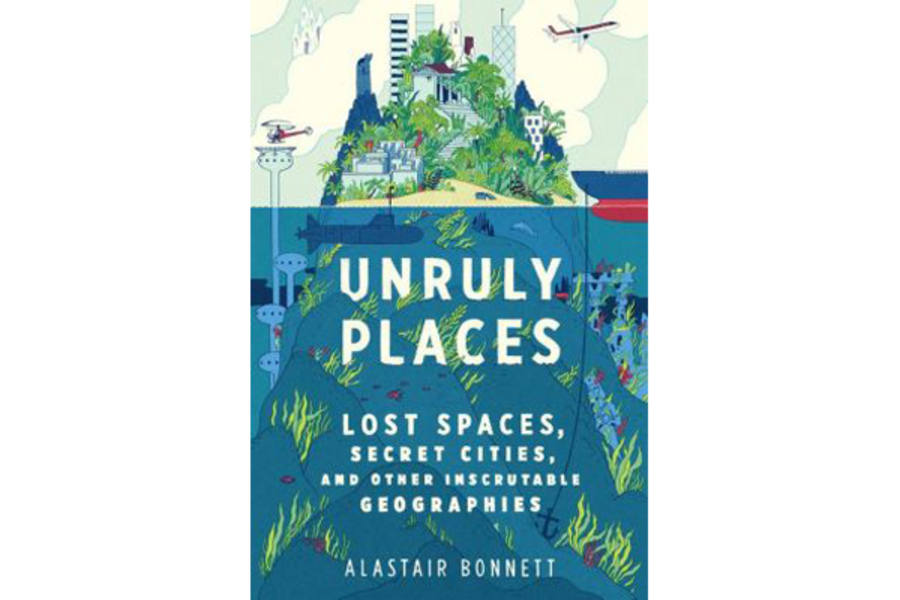'Unruly Places' finds our planet's clandestine, mismapped, abandoned, or repurposed places
Loading...
It is hard, if not impossible, to grasp how large this planet of ours is; our brains aren’t built for the task. You get an inkling of its prodigious breadth if you drive coast to coast (deserts, Great Plains, and Texas craftily elongating the farther you motor), but that’s only a sixth of it – as well as just a straight line. There’s a lot of area left over.
In recent years, though, as social geographer Alastair Bonnett points out in his charmingly perverse compendium of 47 hidden, lost, forgotten, or rediscovered spots (all helpfully identified with exact coordinates), the diminishment of the unknown has put us in an elegiac mood. Our primal impulse for discovery seems to have run into the brick wall of Google Earth – itself built at the far end of half a millennium of assiduous exploration – and the suspicion that every square inch has been mapped, seen, and is perhaps already well on the way to destruction. It’s a sense of loss that has been wept out of late in the pages of books with titles like "Non-Places," "The Geography of Nowhere," and "The Place You Love is Gone" (the latter my own contribution to the genre of terrestrial mourning). Unruly Places is a welcome corrective to this rending of garments: there are still enough clandestine, mismapped, abandoned, or repurposed places left to fill a book – with, it is strongly implied, plenty more where these come from. Because the Age of Exploration now has its successor: the Age of Rediscovery.
Bonnett’s book is a manual for reimagining the notion of exploration itself. The everlasting human need for escape and novelty, travel and conquest, now requires a different – conceptual – map on which to locate the new in a world of creeping “blandscape,” one that proves we are more adept “at destroying places than building them.” Exciting destinations can still be found, they just might not be the pristine wildernesses of yore. To wit, creative adventurers may fix their sights on temporary places like the floating island known as the Pacific Trash Vortex. Or possibly they will consider with wonderment the fact that the Nipterk P-32 Spray Ice Island exists at all, thanks to the work of ExxonMobil. In 1989 the company hosed enough water into the frigid air over the Beaufort Sea to create a frozen landmass of 860,000 cubic meters.
Places come, and places go. Much of the book is devoted to those that have disappeared – such as the Aral Sea, which by human hand has been reduced from the world’s fourth-largest lake to a mere 20 percent of its former self; it has now become the Aralqum Desert. If this news isn’t stunning enough, Bonnett lays on the wow:
"Barsa-Kelmes, which translates as 'the land of no return' in Kazakh, was once the Aral Sea’s largest island and used to be a nature reserve, renowned for its eagles, deer, and wolves. Today it is just another dead stump of land. By 1993 it was empty except for one resident, who refused to leave, and a few stubborn wild asses. It seems that the holdout, an ex-ranger named Valentin Skurotskii, was rooted to the island by the fact that his mother was buried there. His body was discovered in 1998, sitting in a chair with his head in his hands."
Befitting its mission to “disrupt our expectations and to reenchant geography,” the book contains a section on no-man’s-lands. Among these are a Bedouin village repetitively bulldozed by Israeli officials only to spring back again and again, and a 27-kilometer stretch between the borders of Senegal and Guinea that is truly neither here nor there. The section also includes a traffic island in Newcastle. “These places are everywhere, part of everybody’s geographical routine,” invisible in their trash-strewn commonness, and thus ripe for reconnoitering. Bonnett encourages the reader to journey across psychic rather than physical borders to locales that are functionally unowned. Isn’t that what the great explorers sought? Any hill of untaken sand on which to plant their nation’s flag? Here, Bonnett offers, are the places to stake new claims. When every kilometer has long been possessed, a novel type of acquisition, by intellectual creativity, recasts ownership today.
"Unruly Places" perfectly captures the zeitgeist: there may be nothing new under the sun in terms of standard topology, but when the field shifts to psychogeography there are always worlds yet to chart – and young technophiles to do it. The idea that the urban environment offers frontiers the equivalent of any in the New World has been pursued since the 1950s, when the Situationists proposed a playful approach to our built environment; today’s urban expeditionary kit replaces sextants and spyglasses with wire cutters, flashlights, and GoPros. Youths that in a previous century would have betaken themselves to a Himalayan peak or by dogsled into frozen wastes (now themselves covered with waste) venture into a different sort of unclaimed territory. They search out abandoned mental institutions and disused subway stops; they descend into all manner of forgotten undergrounds, such as the vast Labyrinth beneath Minneapolis-St. Paul. Then they catalog their voyages within another recently colonized space, our endless public library without walls. Photographic archives can be found on Imgur (“The 33 Most Beautiful Abandoned Places in the World”) and sites like AbandonedNYC, Ephemeral New York, and Atlas Obscura.
Another hint to the peculiar currency of "Unruly Places" can be found in an inventory of the author’s most frequent descriptors: “disconcerting,” “troubled,” “paradoxical,” “uncomfortable,” “disorienting.” Only natural, when your book is about places made new by becoming old, beautiful when ugliest, present only in the remnants that announce their disappearance. This is where we’re at: Just when we think everything is known, we learn there may be no limits to how much there is to discover.








